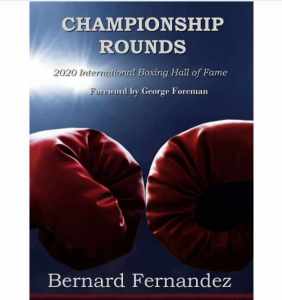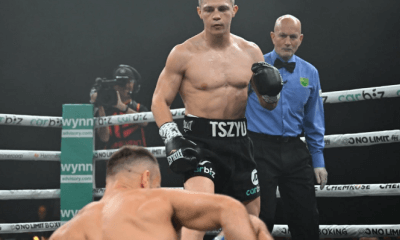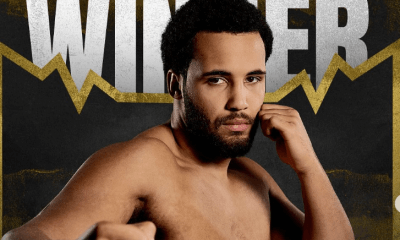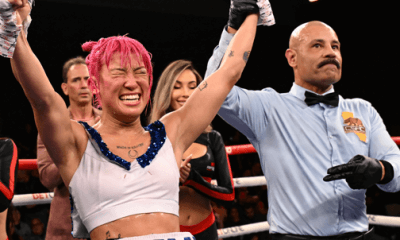Book Review
Book Review: Bernard Fernandez’s “Championship Rounds”

When a man retires after a lengthy career in an interesting occupation, he feels a tug to write his memoir. If he happened to be a journalist, the memoir can take the form of an anthology. Bernard Fernandez’s “Championship Rounds,” released this month, is an anthology – a compendium of previously published material – but it also veers off at times into a memoir, which is a very good thing. It could not be otherwise as Fernandez had a front row seat at the circus and the permit to poke around behind the scenes.
For the uninitiated, Bernard Fernandez spent 43 years as a sportswriter, the last 28 with the Philadelphia Daily News before retiring in 2012. Although he was occasionally assigned to other beats, he was foremost the paper’s boxing guy. When he started with the Daily News, many established papers had a full-time boxing writer. Today they are as scarce as professional typewriter repairmen.
Various honors came Fernandez’s way during his newspaper career, the most recent of which, for a boxing writer, is the ultimate, enshrinement in the International Boxing Hall of Fame. Fernandez was voted into the Hall in the Observer category last year.
There are 35 stories in “Championship Rounds” sorted into six sections. Eighteen of these stories appeared at The Sweet Science. Among the boxers profiled are Ali and Frazier, Jake LaMotta (who Fernandez interviewed for the second time when Jake was 94 years old), Archie Moore, Tex Cobb, Arturo Gatti (“the boxing franchise in Atlantic City”), and the Spinks brothers – Michael, who “wrung every ounce from his considerable boxing gifts,” and Leon, his mirror opposite, “perpetually distracted.”
Many of the giants of the modern era turn up in “Championship Rounds,” but also some cult figures and even Jack Obermayer, somewhat less than a cult figure save among his peers who were awed by his stamina and cherished his friendship. A familiar face at diners up and down the east coast, Obermayer likely attended more boxing shows than any man ever born, 3,514 in total scattered across 400-plus cities in 49 states, all but Alaska. He devoted himself, says Fernandez, “to the proposition that every fight card, no matter how unimportant or seemingly insignificant, required his presence at ringside to be fully validated.”
The best boxing writers understand that boxing is an ecosystem and that some of the best stories are found outside the ropes.
Fernandez was writing about women’s boxing before it was fashionable to write about women’s boxing. It’s doubtful the name Jackie Tonawanda rings a bell, but she was a trailblazer in women’s boxing and Fernandez brings her to life in a story that appeared in these pages back in 2009. I had no clue that the fight between Laila Ali and Jackie Frazier-Lyde created such a stir until I read “Ali-Frazier IV.” Held at the Turning Stone Casino and Resort in Verona, a little town in upstate New York, the event attracted a media throng of 300-plus from around the world.
Bernard Fernandez is a big movie buff. “I’ve frequently imagined that, were I not covering boxing matches and football and basketball games for my weekly recompense, I’d be a movie reviewer,” he writes.
The big screen and the lowbrow amusement of celebrity boxing intersect in “I Tanya…,” a 2019 story inspired by the Tonya Harding biopic starring Margot Robbie and Alison Janney. The movie transported Fernandez back to Portland, Oregon, and the maddeningly unfruitful scrums that bespattered “the worst week of my newspaper career.”
Being a newspaper reporter who racks up frequent flyer miles isn’t all that glamorous as Fernandez showed in that story, but even the most unpleasant episodes can be fun in the re-telling. And sometimes the hassle of getting somewhere is redeemed by a surprising turn of events at the destination. Fernandez’s trip to Tokyo in 1990 was grueling at both ends of the continuum — from the Eastern seaboard, one crosses 14 time zones – but he would be one of the few American scribes to witness live and in color, as they say, the most famous upset in the annals of boxing.

Mike Tyson’s 2002 match with Lennox Lewis wasn’t nearly as momentous – at least not after the bell rang – but Fernandez’s excursion to Memphis, the host city, yielded a story too good to be left on the cutting room floor. The highlight for me was his interview with a tourist from Switzerland as they watched the city’s oddest must-see attraction, the march of the ducks in the ornate lobby of the Peabody Hotel.
Of the 35 entries in the book, my personal favorites are the two that are the most poignant. Bernard Hopkins’ truth-is-stranger-than-fiction life story has been well-documented, but one acquires a greater appreciation of B-Hop while reading about the special bond that he forged with a terminally ill teenage fan. In the book’s final entry, Fernandez pays homage to his late father who instilled within him his love of boxing. Bernard Fernandez Sr., who had a brief pro career under the name Jack Fernandez, was a much-decorated New Orleans police captain who passed away in 1994 at age 75. “It is said that an honest man’s pillow is his peace of mind,” writes Fernandez, “and my father never spent a conflicted night.”
Bernard Fernandez is a friend of mine, something I probably should have acknowledged earlier. Moreover, for the past several years, I have been his editor here at The Sweet Science.
Editors, many of whom exemplify the Peter Principle, are faultfinders by temperament and tutelage, and I would be remiss if I didn’t find something to quibble about.
When writing a feature story about a boxer or boxing personality, Fernandez will sometimes open with a parallelism. For example, a certain boxer may summon up the name of a historical figure with whom he shares characteristics in common. The parallel in a piece about Wladimir Klitschko is Al Davis, the former owner of the Oakland Raiders whose mantra, “Just win, baby,” became the enduring catchphrase of Raider Nation.
I thought the comparison was labored and that Fernandez exhausted too many words about Davis and his team before getting to the gist of his story.
With that nitpicking yammer, I likely just got on the wrong side of George Foreman which is never a smart thing to do. “Writers come and go,” says Foreman in the foreword to the book, “but the special ones (like Bernard Fernandez) stand the test of time.”
On this matter, Big George and me are in perfect accord.
Bravo, Bernard, it was a most enjoyable read and if there is a sequel in the hopper, please don’t let it languish.
For more information about “Championship Rounds” including where to purchase the book CLICK HERE.
Check out more boxing news on video at The Boxing Channel
To comment on this story in The Fight Forum CLICK HERE
-

 Featured Articles4 weeks ago
Featured Articles4 weeks agoThe Hauser Report: Zayas-Garcia, Pacquiao, Usyk, and the NYSAC
-

 Featured Articles3 weeks ago
Featured Articles3 weeks agoOscar Duarte and Regis Prograis Prevail on an Action-Packed Fight Card in Chicago
-

 Featured Articles2 weeks ago
Featured Articles2 weeks agoThe Hauser Report: Cinematic and Literary Notes
-

 Book Review2 weeks ago
Book Review2 weeks agoMark Kriegel’s New Book About Mike Tyson is a Must-Read
-

 Featured Articles4 weeks ago
Featured Articles4 weeks agoRemembering Dwight Muhammad Qawi (1953-2025) and his Triumphant Return to Prison
-

 Featured Articles7 days ago
Featured Articles7 days agoMoses Itauma Continues his Rapid Rise; Steamrolls Dillian Whyte in Riyadh
-

 Featured Articles3 weeks ago
Featured Articles3 weeks agoRahaman Ali (1943-2025)
-

 Featured Articles3 weeks ago
Featured Articles3 weeks agoTop Rank Boxing is in Limbo, but that Hasn’t Benched Robert Garcia’s Up-and-Comers


















